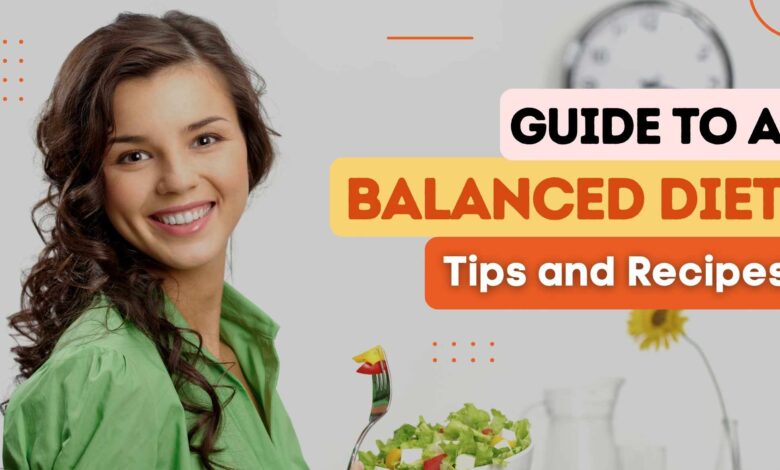
Food. It strengthens our bodies, feeds our minds, and unites us. But navigating the big world of food can be overwhelming. What is a “balanced diet”? How do we translate that into delicious, satisfying food? This guide aims to demystify healthy eating, providing practical advice and delicious recipes to help you on your journey to a balanced diet.
Symphony of Nutrition
Before diving into specific nutrients, let’s explore the components of a balanced diet: macronutrients and micronutrients. Macronutrients (carbohydrates, proteins and fats) are the main source of energy that our body needs for daily activities. Micronutrients (vitamins and minerals) play an important role in many body functions, although they are less needed.
Macronutrients:
Carbohydrates: The body’s main source of energy, carbohydrates are available in simple (sugar) and complex (starch, fiber) forms. Choose complex carbohydrates from whole grains, fruits, and vegetables for energy and healthy digestion.
Protein: Essential for building and repairing tissue, protein comes from animal sources (meat, chicken, fish, eggs) and plant sources (legumes, legumes, nuts). Try to provide a variety of proteins to meet your protein needs.
Fat: Don’t be afraid of fat! Healthy fats (unsaturated fats from avocados, nuts, olive oil) support brain function, hormone production and nutrient absorption. Limit bad fats (saturated fat in red meat, processed foods) that have been linked to heart disease.
Micronutrients:
Vitamins: Two types of vitamins are needed for various functions: fat-soluble vitamins (A, D, E, K) that are stored in the body and water-soluble vitamins (vitamins B and C complex) that need to be supplemented all the time. . Eat a variety of colorful fruits and vegetables to get the best vitamin intake.
Minerals: Dark leafy greens, nuts, seeds, and dairy products are rich in minerals that support bone health, blood production, and more.
Building a Balanced Board: A Practical Guide
Imagine your plate is divided into three parts:
Half: Rich in non-starchy vegetables (broccoli, carrots, spinach) that provide fiber, vitamins and minerals.
Quarter: Fill up on whole grains (brown rice, quinoa, whole wheat bread) to keep up the energy.
Quarter: Rich in lean protein (chicken breast, fish, lentil), used to build and repair tissue.
Add a source of healthy fat (sliced avocado, olive oil) and a piece of fruit (apples, berries) for added flavor. This video guide will help ensure a balanced intake of macronutrients and micronutrients at each meal.
Tips for a balanced diet and lifestyle
Meal planning: Minimize bad surprise choices by planning meals and preparing meals in advance. This saves time and ensures that you have a healthy space.
Read food labels: Don’t be fooled by the marketing! Knowing the portion sizes, ingredients (watch out for added sugar and sodium), and nutritional information will help you make the right choices.
Cooking is more at home: Cooking allows you to control food and portion sizes. Try new recipes to make things better.
Water: Water is important for body function and can suppress appetite. Try to drink eight glasses of water a day.
Remember to eat: Eat slowly, eat well, and you’ll feel full. Avoid distractions such as television or cell phone while eating.
Portion Management: Use small plates to avoid overeating. Pay attention to the dimensions of the parts and attach them.
Variety is important: Explore different food groups and dishes to prepare varied meals. Don’t beat yourself up: It’s always good to improve yourself. The aim is to balance and moderate, not to block.
Listen to your body: Pay attention to hunger and satiety cues. Do not skip meals and eat when you are not hungry.
Make it a journey, not a chore: Eating healthy doesn’t have to be stressful. Find ways to make cooking fun by exploring new recipes, cooking with friends or family, and finding healthy options.
Delicious recipes for a balanced diet
Here are some delicious recipe ideas that use the principles of a balanced diet:
Breakfast:
Power Smoothie Bowl: Combine Greek yogurt, spinach, banana, berries, and almond milk for a fiber-rich breakfast. Top with chia seeds, granola, and chopped almonds for added texture and texture.
Baked Eggs and Whole Wheat Toast with Sliced Avocado: A classic and satisfying breakfast that features protein, healthy fats and whole grains.
Have lunch:
Quinoa Salad with Roasted Vegetables and Roasted Chicken: A healthy and delicious protein salad. Combine roasted quinoa, roasted vegetables (broccoli, bell peppers, onions), grilled chicken breast cubes, chopped fresh herbs (parsley, cilantro) and light lemon vinaigrette for a delicious, satisfying dinner.
Dinner:
Salmon with Roasted Brussels Sprouts and Mashed Potatoes: A hearty and delicious meal. Salmon fillets are grilled with herbs and spices. Toss Brussels sprouts with olive oil and salt to add flavor. Mash potatoes and add a little milk and cinnamon to make it more comforting.
Lentil Soup with Whole Wheat Bread: A delicious vegetarian option. Cook beans and vegetables (carrots, celery, onions), herbs and spices for a delicious protein-rich soup. Serve with whole wheat toast.
Snack:
Fruit and Nut Butter: A filling and nutritious snack. Choose fruits like apples, bananas, and dip them in almond butter or peanut butter to add protein and fiber.
Homemade snack mix: Make your own healthy snack mix using nuts (almonds, cashews), seeds (pumpkin seeds, sunflower seeds), dried fruit (cranberries, raisins) and dark chocolate chips for dessert and sweet
Remember, these are just examples. Explore recipes, online resources, and try different foods to find healthy foods you like.
Stick to a healthy diet:
Creating healthy eating habits takes time and effort. Don’t expect perfection. On your more relaxed days, treat yourself. Celebrate your progress, no matter how small. Remember, eating a balanced diet means feeling good, strong, and nourishing your body from the inside out.




